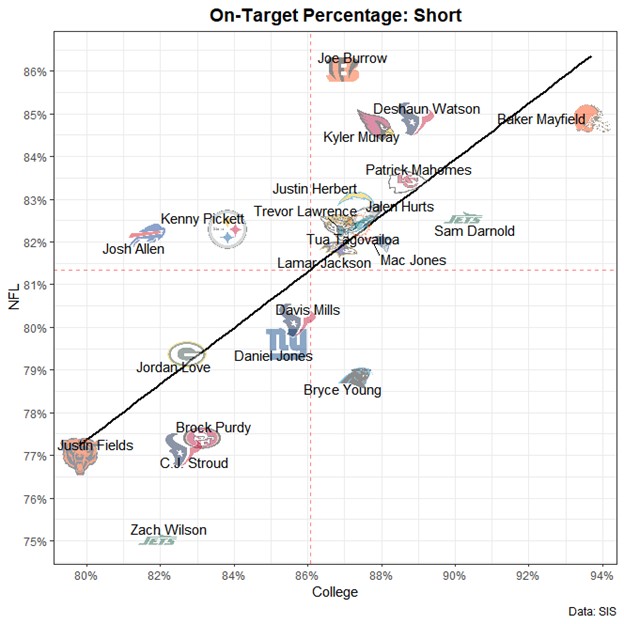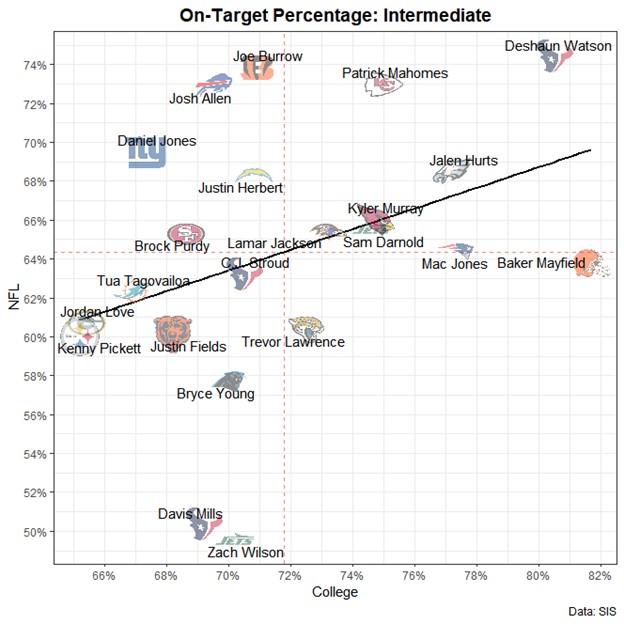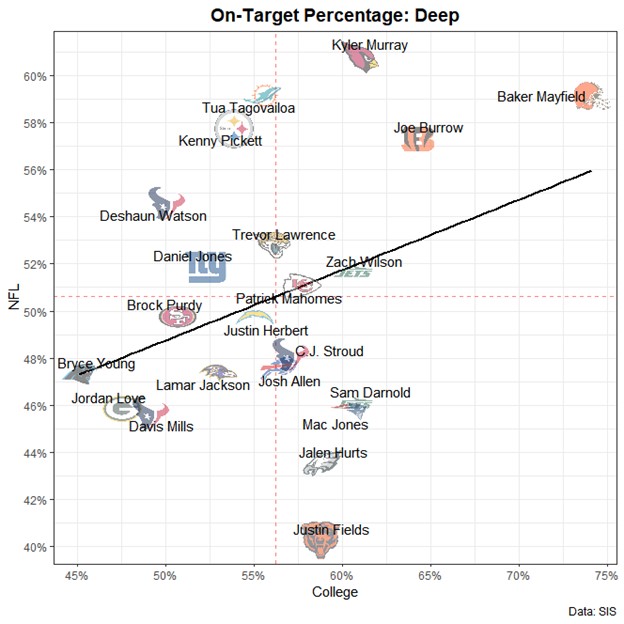Photo: Andy Altenburger/Icon Sportswire
The NFL Draft is always a tricky thing to figure out. Drafting well can propel a franchise for sustained success, but whiffing on picks, especially at the top of the draft, can set a team back for years. This applies even more so when it comes to quarterbacks. Teams are constantly trying to find the slightest edge over their competition, and so there is great value in discerning if an aspect of a player’s play in college can reliably indicate how they will perform in that same aspect in the NFL.
For that purpose, we wanted to investigate how strong of a correlation existed between a quarterback’s accuracy in college and in the NFL. To give it a little more specificity, we compared on-target percentage between college and the NFL at three specific depths. When running correlation and linear regression tests, we got results that are in line with what one would have expected, in terms of on-target percentage for short passes having the strongest correlation between college and the NFL.
| On-Target Percentage Depth | Correlation Coefficient | Adjusted R2 |
| Short (< 11 yards) | 0.73 | 0.50 |
| Intermediate (11-20 yards) | 0.36 | 0.09 |
| Deep (> 20 yards) | 0.34 | 0.07 |
The above table shows how career college on-target percentage at different depths predicts NFL on-target percentage in the first 2 to 3 years (at least 2 years and 300 passing attempts, at most 3 years). SIS started tracking college football in 2016 and 22 quarterbacks qualified by these criteria since then.
While the order of correlation may not be the most exciting discovery, just how strong the correlation is for short passes is worth paying attention to. At the very least, a prospect’s college on-target percentage for short passes is a good piece of context to include when considering how accurate he could be at that depth at the next level.

When observing the graph above, there are other interesting bits of information to take away. Let’s take a moment to compare Josh Allen and Zach Wilson. Both came out of college being described as boom-or-bust prospects with big arms and a penchant for big plays, but questionable accuracy, decision making, and reliance on hero ball at times. We can see that in college they had similar accuracy on short throws (and intermediate throws as well, as seen in the graph below), but at the next level Allen has been able to deliver accuracy above expectations while Wilson’s accuracy has been underwhelming. This offers insight on one potential factor out of many for why their careers have taken different directions.


Results for correlation testing at the intermediate and deep levels are not as strong, though not insignificant and therefore still worth mentioning. One note to take away from all three charts is that Baker Mayfield was the most accurate at all three depths in college and that has translated into him now being one of the more accurate passers in the NFL, a trait that belies his gunslinger reputation.
On-Target Percentage and Overall QB Performance
With these results in mind, we wanted to discover whether they could tell us anything in terms of performance, and therefore we performed correlation testing between on-target percentages and IQR (Independent Quarterback Rating, an SIS quarterback metric that builds on the traditional Passer Rating formula by considering the value of a quarterback independent of results outside of the his control such as dropped passes, dropped interceptions, throwaways, etc.).
| NFL Accuracy by Depth | Correlation with NFL IQR |
| Short (< 11 yards) | 0.55 |
| Intermediate (11-20 yards) | 0.74 |
| Deep (> 20 yards) | 0.24 |
First, we wanted to test with NFL accuracy numbers because if there was no significant correlation, then there would not be much reason to check for correlation between college on-target percentage and NFL IQR. We can see that short and especially intermediate accuracy share a strong correlation to QB performance and therefore being more accurate on intermediate throws could be a little more valuable when evaluating prospects than at other depths.
| College Accuracy by Depth | Correlation with NFL IQR |
| Short (< 11 yards) | 0.34 |
| Intermediate (11-20 yards) | 0.38 |
| Deep (> 20 yards) | 0.16 |
When testing with college accuracy numbers, the results are understandably not as strong. However, the strength of correlation follows the same order with intermediate on-target percentage coming in first, followed by short, and then lastly deep. Deep accuracy showing weak correlation to QB performance makes some sense on an intuitive level even if solely because long throws are rarer and more volatile in nature.
2024 Draft Class
The 2024 draft class was not included in the study above due to having only one season under its belt. However, evaluating their rookie seasons against their college careers (both with a minimum of 300 attempts) could prove useful in terms of identifying bounce back or regression candidates. Among these players, when taking a look at Caleb Williams, his intermediate on-target percentage had the largest drop off at any depth between college and the NFL. If his intermediate accuracy bounces back, we could see better production from him in year two.
| Stats | Bo Nix | Caleb Williams | Drake Maye | Jayden Daniels |
| Coll OnTgt% Short | 83% | 84% | 79% | 78% |
| NFL OnTgt% Short | 83% | 81% | 83% | 80% |
| College OnTgt% Intermediate | 60% | 63% | 63% | 63% |
| NFL OnTgt% Intermediate | 61% | 48% | 55% | 64% |
| College OnTgt% Deep | 52% | 47% | 50% | 49% |
| NFL OnTgt% Deep | 44% | 40% | 43% | 54% |
| NFL IQR | 92.7 | 88.0 | 84.8 | 104.6 |
2025 Draft Class
Looking ahead to the 2025 draft class, outside of Riley Leonard and Tyler Shough, the other eight prospects are fairly bunched together in terms of their short accuracy in college, so making any meaningful predictions for how they will compare to each other at the next level could prove difficult. One nugget to file away is Jaxson Dart’s lead in accuracy on intermediate throws, potentially one positive indicator for his overall performance if he is able to replicate that level of precision in the NFL.
| Player | OnTarget% Short | OnTarget% Intermediate | OnTarget% Deep |
| Cameron Ward | 82% | 67% | 46% |
| Dillon Gabriel | 84% | 64% | 58% |
| Jalen Milroe | 82% | 56% | 51% |
| Jaxson Dart | 84% | 74% | 51% |
| Kurtis Rourke | 83% | 62% | 51% |
| Kyle McCord | 81% | 61% | 55% |
| Quinn Ewers | 82% | 66% | 48% |
| Riley Leonard | 79% | 59% | 45% |
| Shedeur Sanders | 83% | 69% | 55% |
| Tyler Shough | 79% | 58% | 47% |
| Will Howard | 81% | 60% | 49% |
Conclusion
While recognizing the limitations of sample size and various factors outside of a quarterback’s control, our study shows there is some value in considering a quarterback’s accuracy in college, especially on short throws, when projecting how accurate he may be at the same distances in the NFL.
Separately, we found that accuracy on intermediate throws had the strongest correlation with a quarterback’s overall performance, with short throw accuracy coming in second. Deep accuracy had a significantly weaker correlation, presumably due to deep throws inherently being more volatile, at least in part. While dropping a 60 yard bomb right into a receiver’s hands may draw the most applause, a quarterback’s accuracy at shallower depths may prove to be more insightful when projecting how he might perform in the NFL.
